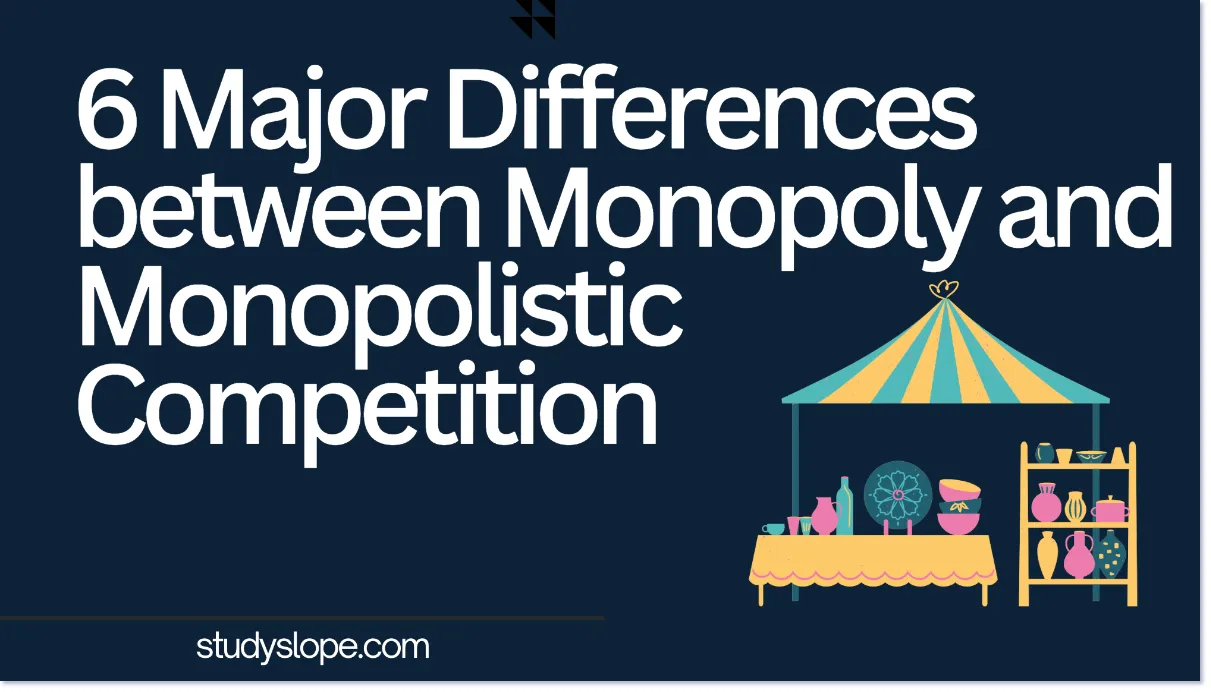Table of Contents
Comprehending the differences between monopoly and monopolistic competition is essential for comprehending the functioning and effects of various market arrangements on both enterprises and consumers. Here is a comprehensive study of these differences:
Major Differences between Monopoly and Monopolistic Competition
1.Definition of the Market
Monopoly: Monopoly refers to a market system in which there is only one seller or manufacturer who has complete control over the whole market, with no viable alternatives available for the product or service. This monopolistic corporation dominates the market and establishes pricing without facing any competition.
Monopolistic competition: It refers to a market system in which several vendors provide distinct items that are similar but not identical. Every company possesses a certain level of market dominance, however it nevertheless encounters competition from other companies that provide similar products
2. Player Count
Monopoly: A single player exercises complete control over the market. This only seller possesses substantial market power and has the ability to manipulate pricing and production levels without being constrained by competition.
Monopolistic competition: it refers to a market structure where several vendors engage in competition. Every company provides a product that has minor variations compared to the products offered by other companies, resulting in intense rivalry among the enterprises.
3. Level of Competition
Monopoly: The absence of competition arises from the presence of a sole vendor in the market. The absence of competition enables the monopolist to choose pricing and production levels without much consideration for consumer preferences.
Monopolistic competition: Monopolistic competition is characterized by intense rivalry as several enterprises compete for market dominance. Product difference fosters competitiveness that depends on variables like as pricing, quality, and marketing strategies.
4. Entry Barriers
Monopoly: The presence of high barriers to entry acts as a deterrent for other companies attempting to enter the market. These obstacles may encompass significant initial expenses, authority over crucial assets, legal limitations, and advantages gained from large-scale operations.
Monopolistic competition: It is characterized by the presence of low barriers to entry, which means that new enterprises can enter the market with relative ease. The accessibility of entering the market fosters rivalry and innovation, as companies endeavor to distinguish their items and allure buyers.
5. Demand Curve
Monopoly: In a monopoly, the demand curve is steep because the monopolist has exclusive control over the product’s supply. Due to the absence of substitutes, consumers exhibit a low level of price elasticity, resulting in a reduced responsiveness of quantity required to changes in price.
Monopolistic competition: In monopolistic competition, the demand curve is less steep due to the presence of several competitors offering comparable items. Consumers have the ability to readily transition to a rival company if the prices set by one firm become too elevated, resulting in a heightened responsiveness of the amount requested to fluctuations in price.
6. Regulation of Prices
Monopoly: In a monopoly, the monopolist possesses substantial authority to determine the price due to its exclusive position as the sole provider in the market. The company has the ability to establish pricing in order to optimize earnings without any concern of losing clients to rivals.
Monopolistic competition: Monopolistic competition refers to a market structure where firms possess a certain level of influence over prices, however this power is constrained by the availability of similar alternatives. Consumers have the ability to switch to a rival if a business increases its prices excessively, which helps maintain a generally competitive pricing environment.
The given table will help students grasp the differences between monopoly and monopolistic competition:
| Aspect | Monopoly | Monopolistic Competition |
|---|---|---|
| Definition | Single seller, no close substitutes | Many sellers, differentiated products |
| Number of Players | One | Many |
| Degree of Competition | None | High |
| Barriers to Entry | High | Low |
| Demand Curve | Steep | Flat |
| Price Control | Significant | Limited |
Monopoly and monopolistic competition are two different market arrangements that impact corporate operations and customer outcomes. A monopoly is characterized by the dominance of a single entity in the market, where there is no competition and the firm has the ability to set prices with significant autonomy. This is made possible by the presence of strong barriers to entry and a steep demand curve.
On the other hand, monopolistic competition is characterized by the presence of several enterprises that engage in competition through product differentiation. As a result, there are reduced obstacles for new entrants, a more even demand curve, and a limited ability to regulate prices because of the presence of similar alternatives.
We hope that this article will help the learners to gain a clear understanding differences between monopoly and monopolistic competition. To learn more about it check our recent article on Monopolistic Competition.

